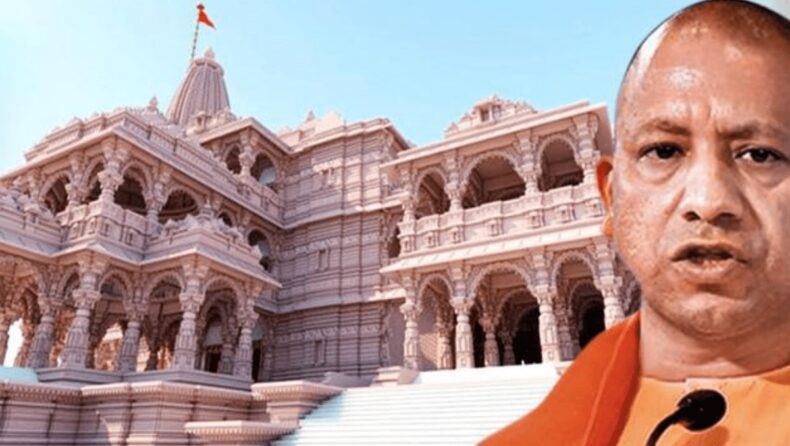CM Yogi Adityanath on Thursday said over 50% work of Shree Ram temple in Ayodhya has been completed.
Uttar Pradesh Chief Minister Yogi Adityanath, who attended a programme at Shri Panchkhand Peeth in Rajasthan, on October 06 said over 50 per cent of work on the under-construction Ram Mandir in Ayodhya has been completed. Addressing the programme at Shri Panchkhand Peeth, Rajasthan, CM Yogi said,
“Dedicated efforts were made to realise the dream of Ram Mandir for which a movement was started in 1949. Now, because of these efforts, over 50 per cent of the work of the temple has been completed.”
The Supreme Court, on 16 October 2019, concluded hearings in the Ram Janmabhoomi-Babri Masjid land dispute in Ayodhya and reserved its judgment, which was passed on 9 November. The apex court, in a unanimous verdict, gave the ownership of the disputed 2.77-acre land in Ayodhya to the Ram Janmabhoomi trust.

The foundation stone for the construction of Ram Temple’s ‘Garbha Griha’ or the sanctum sanctorum of the temple was laid by Uttar Pradesh Chief Minister Yogi Adityanath in June this year.
The construction of the temple of Lord Ram in Ayodhya is going on at a fast pace. On 5 August 2020, Prime Minister Narendra Modi laid the foundation stone of the Ram temple and since then the construction work of the temple is going on.
Addressing the programme at Shri Panchkhand Peeth, Rajasthan, CM Yogi said, “Mahatma Ramchandra Veer Ji Maharaj and Swami Acharya Dharmendra Ji Maharaj were the ones who contributed selflessly towards the country. The ‘Peeth’ also played a crucial role in ensuring public participation in various campaigns led by the saints for the welfare of the country.
“During the ‘Chadarposhi’ ceremony of Swami Somendra Sharma, Adityanath said that Acharya Dharmendra had a deep connection with Gorakshapeeth for three generations.

While addressing the ‘Sant Samagam’, Chief Minister Yogi Adityanath said
“He further said, “Dedicated efforts were made to realise the dream of Ram Mandir for which the movement started in 1949. Resultantly, today, over 50 per cent of work on the Ram Mandir, which was also a dream of Acharya Ji, has neared completion.
“The CM said that Acharya ji used to express his views in a frank and rational manner. The result of this is that the Hindu community keeps reverence and respect for him. “Today, even when Acharya Ji is not present physically, his values, ideals and contribution remain alive among us all,” he said.
Importance of Ayodhya Ram Mandir for Hindus
Ram Temple is the place on which Lord Vishnu was born as form Lord Ram of the 7th Avatar. The place is located in Ayodhya city, Uttar Pradesh, India. There is a temple dedicated to Lord Ram on the birthplace. This is a disputed place which is between Hindus and Muslims.

It is believed that this place was a religious place for Muslims from 1528 to 1853. Political, historical and socio-religious debates at the history and place of Babri Masjid and Ram birth place, where was the temple and the temple was demolished or modified to make it, which is called the Ayodhya dispute.
In 1992, the demolition of Babri Masjid by Hindu nationalists gave birth to widespread Hindu-Muslim violence. Archaeological excavation has indicated the presence of a temple under the mosque’s debris.
A brief History of Ram Janmbhumi controversy is as follows
- In 1528, the mosque was built on the birth place of Ram. According to the mythical granth Ramayana and Ramcharit Manas of Hindus, Lord Rama was born here.
- In 1853, this land was first dispute between Hindus and Muslim.
- In 1859, the British asked the Muslims to take part inside of the place for prayers and the Hindu to take outside part of the place for worship, keeping in mind the dispute.
- In 1949, the statue of Lord Rama was kept in the inner part. Seeing the tension rising, the government locked it in its gate.
- In 1986, the District Judge ordered the disputed site to be opened for worship of Hindus. The Muslim community constituted the Babri Masjid Action Committee against it.
- In , the Vishwa Hindu Parishad launched a Ram temple campaign on the land adjacent to the disputed site.
- On December 6, 1992, Hindu nationalists demolished the mosque, resulting in more than 2,000 deaths in communal riots.
- 10 days later, on December 16, 1992, the Liberhan Commission was constituted. Retired Chief Justice of Andhra Pradesh High Court M.S. Libran was appointed the Chairman of the Commission.
- The Liberhan Commission was asked to submit report on March 16, i.e., in three months, but the commission has spent 17 years in the report.On June 30, 2009, the Liberhan commission handed over 700 pages of report in four parts to Prime Minister Dr. Manmohan Singh and Home Minister P. Chidambaram.
- The term of the inquiry commission was extended 48 times.
- The term of the Liberhan Commission, which ended March 31, 2009, extended for three months i.e., till 30th June.
- On 9 November 2019, the Supreme Court gave its final verdict, and ordered the Central Government to make the institution for the construction of the temple in 3 months to build the Ram temple at the disputed site. The Central Government was ordered to give 5 acres of land to the Muslim side only.












